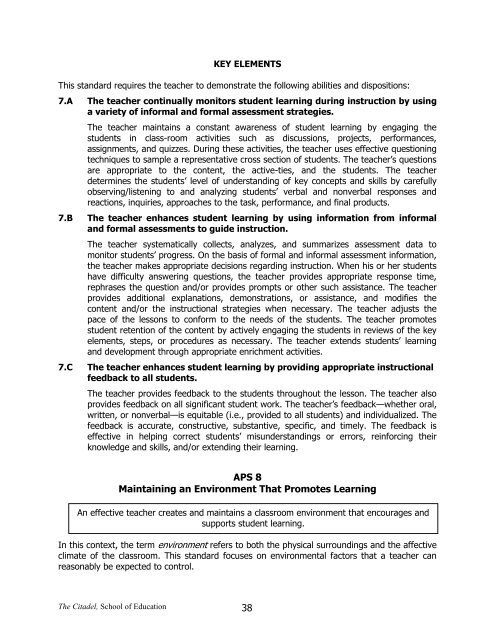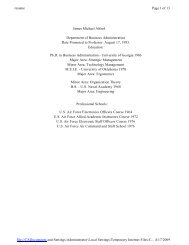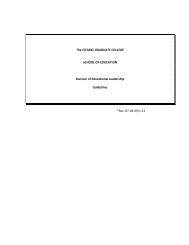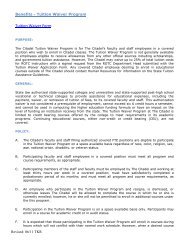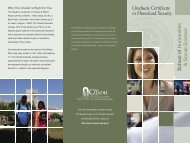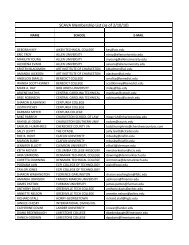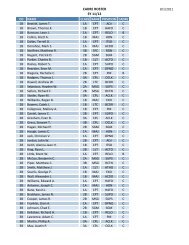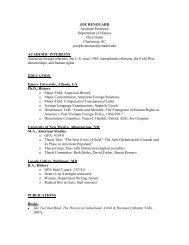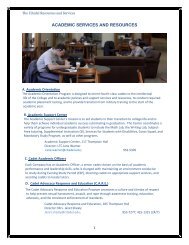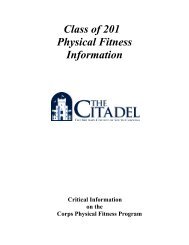Guidelines for Student Teaching Internship - The Citadel
Guidelines for Student Teaching Internship - The Citadel
Guidelines for Student Teaching Internship - The Citadel
You also want an ePaper? Increase the reach of your titles
YUMPU automatically turns print PDFs into web optimized ePapers that Google loves.
KEY ELEMENTSThis standard requires the teacher to demonstrate the following abilities and dispositions:7.A <strong>The</strong> teacher continually monitors student learning during instruction by usinga variety of in<strong>for</strong>mal and <strong>for</strong>mal assessment strategies.<strong>The</strong> teacher maintains a constant awareness of student learning by engaging thestudents in class-room activities such as discussions, projects, per<strong>for</strong>mances,assignments, and quizzes. During these activities, the teacher uses effective questioningtechniques to sample a representative cross section of students. <strong>The</strong> teacher’s questionsare appropriate to the content, the active-ties, and the students. <strong>The</strong> teacherdetermines the students’ level of understanding of key concepts and skills by carefullyobserving/listening to and analyzing students’ verbal and nonverbal responses andreactions, inquiries, approaches to the task, per<strong>for</strong>mance, and final products.7.B <strong>The</strong> teacher enhances student learning by using in<strong>for</strong>mation from in<strong>for</strong>maland <strong>for</strong>mal assessments to guide instruction.<strong>The</strong> teacher systematically collects, analyzes, and summarizes assessment data tomonitor students’ progress. On the basis of <strong>for</strong>mal and in<strong>for</strong>mal assessment in<strong>for</strong>mation,the teacher makes appropriate decisions regarding instruction. When his or her studentshave difficulty answering questions, the teacher provides appropriate response time,rephrases the question and/or provides prompts or other such assistance. <strong>The</strong> teacherprovides additional explanations, demonstrations, or assistance, and modifies thecontent and/or the instructional strategies when necessary. <strong>The</strong> teacher adjusts thepace of the lessons to con<strong>for</strong>m to the needs of the students. <strong>The</strong> teacher promotesstudent retention of the content by actively engaging the students in reviews of the keyelements, steps, or procedures as necessary. <strong>The</strong> teacher extends students’ learningand development through appropriate enrichment activities.7.C <strong>The</strong> teacher enhances student learning by providing appropriate instructionalfeedback to all students.<strong>The</strong> teacher provides feedback to the students throughout the lesson. <strong>The</strong> teacher alsoprovides feedback on all significant student work. <strong>The</strong> teacher’s feedback—whether oral,written, or nonverbal—is equitable (i.e., provided to all students) and individualized. <strong>The</strong>feedback is accurate, constructive, substantive, specific, and timely. <strong>The</strong> feedback iseffective in helping correct students’ misunderstandings or errors, rein<strong>for</strong>cing theirknowledge and skills, and/or extending their learning.APS 8Maintaining an Environment That Promotes LearningAn effective teacher creates and maintains a classroom environment that encourages andsupports student learning.In this context, the term environment refers to both the physical surroundings and the affectiveclimate of the classroom. This standard focuses on environmental factors that a teacher canreasonably be expected to control.<strong>The</strong> <strong>Citadel</strong>, School of Education 38


